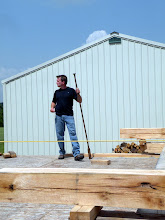
Hugh Rogan was an Irish immigrant who settled here in Sumner county back in the late 18th century. He settled the community of Rogana near Bethpage Tn. You can see his original stone house above.Hugh was responsible for bringing Catholics to this area. His son built a second home in the early 19th century. The National Museums of Northern Ireland have purchased this 2nd historic home to dismantle and ship to Ireland to be re-assembled. This is where I come in. Several of us have been commisioned to build furniture from that period based on records from Sumner county to complete the restoration. I will be building a settee based on one fron 1828 that use to sit on the porch of Wynnewood. This is a historic home that was damaged by a tornado 3 years ago. With the help of John Garrott I was able to measure the original settee which was also damaged and in storage. Below is the settee pictured at the bottom of the page out of the book "The Art & Mystery of Tennessee Furniture Makers before 1850".

Pictured below is the condition the settee is in now. It is in great need of repair but I am able to get enough measurements to make a reproduction.

I mentioned John Garrott who at 82 years old could probably work circles around me. He started the Sumner county museum back in the 70's. He is involved with a lot of historic sights in this area. Now he makes reproductions of 18th and 19th century furniture. You can see John below showing me the chair he made for the Hugh Rogan house(pictured at top) which was moved to the Bledsoe Creek historic sight. John made most of the furniture in this house.
The settee has to be completed by late April to be shipped over to Ireland. I will post on the progress soon.








